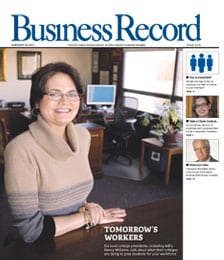Digital design shapes the art of custom jewelry

Designing jewelry from scratch used to be a tedious and imprecise process. A customer would have an idea and sketch it crudely or describe it to a jeweler. The jeweler would then try to envision the piece, put that design on paper and see if it was what the customer wanted. Next, the customer and the jeweler would tweak the design until they came to an agreement. The jeweler would hand-carve a mockup in dense wax, and the customer would, for the first time, see what the design looked like in three dimensions. Adjustments would be made to the wax model, and eventually the actual jewelry would be created.
Now that’s all changed, according to Bruce Owen, owner of Amerigem Corp. jewelry store. New computer software is shaking up the way jewelry stores do business, Amerigem included.
Owen, who has been in the business for 21 years and began designing jewelry in high school, recently completed a two-week training course in Gemvision Corp.’s Matrix 3-D and Digital Goldsmith 4.0 computer programs. Other Amerigem employees and workers from Krehlik Spiller & Co., the in-house company that manufactures Amerigem’s customized jewelry, attended as well.
Davenport-based Gemvision’s Matrix 3-D computer-aided design software simplifies the design process with menus to enter parameters for common jewelry elements and tools to alter the design. It also allows the designer and customer to look at the piece from every angle. Gemvision’s Digital Goldsmith 4.0 shows on screen and in scale what the piece of jewelry will look like before it is actually produced. Then the computer data can be fed into a machine that either carves a prototype out of wax, or builds one by layering wax.
What used to take three to 25 hours now takes 45 minutes to two hours, Owen said, and the new wax prototypes accurately mirror the specifications of the CAD design.
“It’s jewelry made precisely for the gem and the finger, because everyone is different,” he said. “Customers are starting to expect [customized products]. When they go in to buy furniture or a car, they say, ‘I like that car, but can I see it in blue?’ or “I like that couch, but can I have it in a different fabric?'”
Just as custom furniture stores can now use computer programs to show how a different fabric would alter a couch’s appearance, Amerigem can now show customers how their ring would look in gold or platinum, with a diamond or a ruby.
“My customers love it,” Owen said, citing an incident in which a client didn’t understand an element he wanted to incorporate into a necklace. He described it, sketched it and showed examples. She still wasn’t sure it was what she wanted. When he created a computer rendering and showed it to her onscreen, she finally knew what he meant and ordered the piece.
“It gave her the confidence to make the decision,” he said. “I think all jewelers concerned about their product will have it soon. It’s just the evolution of the industry.”
The bulk of Owen’s business is jewelry he designs, whether pieces to go in a showcase or made for a specific customer. He says he decided to open his own jewelry store when he noticed the gradual decline of customer service in the industry over the decades.
“Jewelers used to be a reputable part of the community,” he said. “Every piece has a story; it’s special to the person buying it or the person receiving it. That should be important to the person selling the piece, too.”







